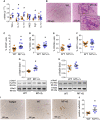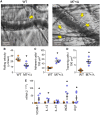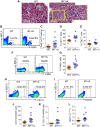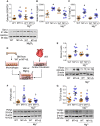Chanzyme TRPM7 protects against cardiovascular inflammation and fibrosis
- PMID: 31250885
- PMCID: PMC7252442
- DOI: 10.1093/cvr/cvz164
Chanzyme TRPM7 protects against cardiovascular inflammation and fibrosis
Abstract
Aims: Transient Receptor Potential Melastatin 7 (TRPM7) cation channel is a chanzyme (channel + kinase) that influences cellular Mg2+ homeostasis and vascular signalling. However, the pathophysiological significance of TRPM7 in the cardiovascular system is unclear. The aim of this study was to investigate the role of this chanzyme in the cardiovascular system focusing on inflammation and fibrosis.
Methods and results: TRPM7-deficient mice with deletion of the kinase domain (TRPM7+/Δkinase) were studied and molecular mechanisms investigated in TRPM7+/Δkinase bone marrow-derived macrophages (BMDM) and co-culture systems with cardiac fibroblasts. TRPM7-deficient mice had significant cardiac hypertrophy, fibrosis, and inflammation. Cardiac collagen and fibronectin content, expression of pro-inflammatory mediators (SMAD3, TGFβ) and cytokines [interleukin (IL)-6, IL-10, IL-12, tumour necrosis factor-α] and phosphorylation of the pro-inflammatory signalling molecule Stat1, were increased in TRPM7+/Δkinase mice. These processes were associated with infiltration of inflammatory cells (F4/80+CD206+ cardiac macrophages) and increased galectin-3 expression. Cardiac [Mg2+]i, but not [Ca2+]i, was reduced in TRPM7+/Δkinase mice. Calpain, a downstream TRPM7 target, was upregulated (increased expression and activation) in TRPM7+/Δkinase hearts. Vascular functional and inflammatory responses, assessed in vivo by intra-vital microscopy, demonstrated impaired neutrophil rolling, increased neutrophil: endothelial attachment and transmigration of leucocytes in TRPM7+/Δkinase mice. TRPM7+/Δkinase BMDMs had increased levels of galectin-3, IL-10, and IL-6. In co-culture systems, TRPM7+/Δkinase macrophages increased expression of fibronectin, proliferating cell nuclear antigen, and TGFβ in cardiac fibroblasts from wild-type mice, effects ameliorated by MgCl2 treatment.
Conclusions: We identify a novel anti-inflammatory and anti-fibrotic role for TRPM7 and suggest that its protective effects are mediated, in part, through Mg2+-sensitive processes.
Keywords: Cardiac hypertrophy; Cations; Magnesium channel; Vascular inflammation.
© The Author(s) 2019. Published by Oxford University Press on behalf of the European Society of Cardiology.
Figures








Comment in
-
The TRPM7 channel kinase: rekindling an old flame or not?Cardiovasc Res. 2020 Mar 1;116(3):476-478. doi: 10.1093/cvr/cvz229. Cardiovasc Res. 2020. PMID: 31504274 No abstract available.
References
-
- Nadler MJ, Hermosura MC, Inabe K, Perraud AL, Zhu Q, Stokes AJ, Kurosaki T, Kinet JP, Penner R, Scharenberg AM, Fleig A.. LTRPC7 is a Mg.ATP-regulated divalent cation channel required for cell viability. Nature 2001;411:590–595. - PubMed
-
- Yogi A, Callera GE, Antunes TT, Tostes RC, Touyz RM.. Transient receptor potential melastatin 7 (TRPM7) cation channels, magnesium and the vascular system in hypertension. Circ J 2011;75:237–245. - PubMed
Publication types
MeSH terms
Substances
Grants and funding
LinkOut - more resources
Full Text Sources
Medical
Molecular Biology Databases
Research Materials
Miscellaneous

